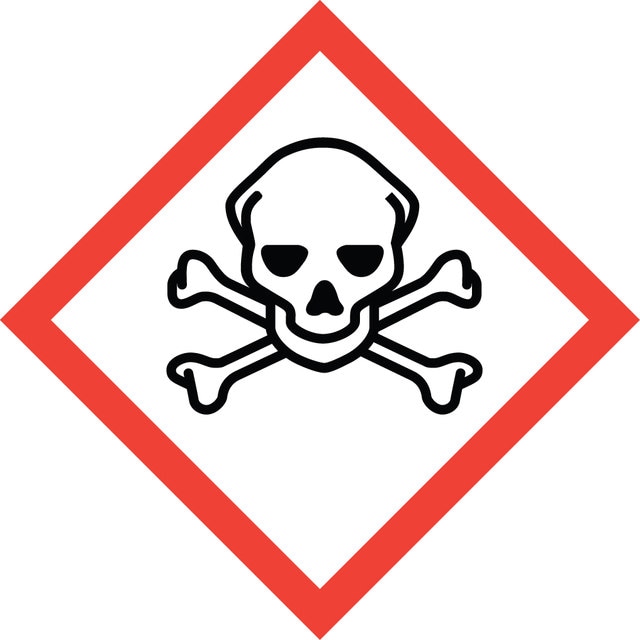SAE0089
Streptolysin O aus Streptococcus pyogenes
≥1,000,000 units/mg protein, recombinant, lyophilized powder, expressed in E. coli
Synonym(e):
Streptolysin O from Streptococcus pyogenes, SLO
Technischer Dienst
Benötigen Sie Hilfe? Unser Team von erfahrenen Wissenschaftlern ist für Sie da.
Unterstützung erhaltenTechnischer Dienst
Benötigen Sie Hilfe? Unser Team von erfahrenen Wissenschaftlern ist für Sie da.
Unterstützung erhaltenAssay
≥95% (SDS-PAGE)
Spezifische Aktivität
≥1,000,000 units/mg protein
Mol-Gew.
60 kDa
UniProt-Hinterlegungsnummer
Versandbedingung
ambient
Lagertemp.
2-8°C
Allgemeine Beschreibung
Streptolysin O (SLO) is an immunogenic, oxygen-labile toxin, hemolytic exotoxin which is reversibly activated by dithiothreitol. [1] It is released into the extracellular medium along with other toxins, including streptolysin S, during the growth of most strains of group A and many strains of groups C and G Streptococci. [1,2] SLO and Streptolysin S differ from each other in that SLO is immunogenic and oxygen-labile while Streptolysin S is oxygen-stable, nonimmunogenic and only active when associated with a carrier protein.[3] The hemolytic activity of SLO is mediated by formation of multimeric nanopores in cholesterol containing lipid membranes.
SLO may be used for cell permeabilization or hemolysis. The susceptibility of hemolysis by SLO varies significantly for erythrocytes from different animal species.[1] Permeabilization of cells using SLO has been performed on multiple cell types and for various applications. For instance it has been used to introduce antisense oligonucleotides into cultured eukaryotic cells;[3] to investigate the effect of guanine nucleotide analogues on phosphatidylinositol metabolism and protein kinase C (PKC) activation in live human T lymphocytes;[4] to monitor cholesterol oxidation within a membrane lipid bilayer; [5] and to label proteins inside living cells using external fluorophores.[6]
SLO may be used for cell permeabilization or hemolysis. The susceptibility of hemolysis by SLO varies significantly for erythrocytes from different animal species.[1] Permeabilization of cells using SLO has been performed on multiple cell types and for various applications. For instance it has been used to introduce antisense oligonucleotides into cultured eukaryotic cells;[3] to investigate the effect of guanine nucleotide analogues on phosphatidylinositol metabolism and protein kinase C (PKC) activation in live human T lymphocytes;[4] to monitor cholesterol oxidation within a membrane lipid bilayer; [5] and to label proteins inside living cells using external fluorophores.[6]
Anwendung
Permeabilisiert Membranen, um die Aufnahme großer oder geladener Moleküle in die Zelle zu ermöglichen.
Biochem./physiol. Wirkung
Thiol-aktiviertes Toxin, dass die Zellmembranen von Tieren permeabilisiert.
Thiol-aktiviertes Toxin, dass die Zellmembranen von Tieren permeabilisiert. Das Protein bindet als Monomer an das Cholesterin von Membranen und polymerisiert in der Folge zu großen, bogen- und ringförmigen Strukturen, die Poren > 12 nm umgeben.
This product is produced by recombinant expression in Escherichia coli and contains the complete native protein sequence of SLO (Uniport ID: P0DF96 aa 34-571) without any added purification tags and has calculated molecular weight of 60,144 Dalton. The material is lyophilized from a solution containing 20 mM Sodium Hepes pH 7.5, 150 mM Sodium Chloride and 2 mM EDTA.
Einheitendefinition
Lyophilized powder containing Hepes buffer salts and EDTA.
One unit will cause 50% lysis of 50 ul of a 2% human red blood cell suspension in phosphate buffered saline, pH 7.4, at 37 °C for 30 minutes.
Still not finding the right product?
Explore all of our products under Streptolysin O aus Streptococcus pyogenes
Signalwort
Danger
H-Sätze
Gefahreneinstufungen
Acute Tox. 2 Dermal - Acute Tox. 2 Inhalation - Acute Tox. 2 Oral
Lagerklassenschlüssel
6.1A - Combustible acute toxic Cat. 1 and 2 / very toxic hazardous materials
WGK
WGK 3
Flammpunkt (°F)
Not applicable
Flammpunkt (°C)
Not applicable
Hier finden Sie alle aktuellen Versionen:
Analysenzertifikate (COA)
Lot/Batch Number
Die passende Version wird nicht angezeigt?
Wenn Sie eine bestimmte Version benötigen, können Sie anhand der Lot- oder Chargennummer nach einem spezifischen Zertifikat suchen.
Besitzen Sie dieses Produkt bereits?
In der Dokumentenbibliothek finden Sie die Dokumentation zu den Produkten, die Sie kürzlich erworben haben.
